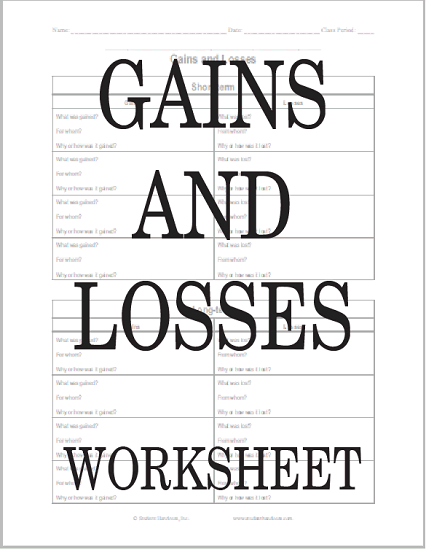Gains and Losses Chart |
| www.studenthandouts.com > Social Studies > Social Studies Handouts |
 |
 |
|---|
Click
here to print this
worksheet. Short- and long-term gains and losses chart. Useful for any sort of major historical event, military battle,
etc. |
|
Tracking short- and long-term gains and losses is also helpful for several other reasons.
Financial Planning: Monitoring gains and losses allows individuals and businesses to plan their financial future more effectively. It helps in budgeting, setting financial goals, and making informed investment decisions. Risk Management: By tracking gains and losses, individuals and businesses can assess their risk exposure. It enables them to make adjustments to their financial strategies to minimize potential losses. Decision-Making: Having a clear picture of financial gains and losses provides valuable information for decision-making. It helps individuals and organizations evaluate the financial implications of various choices and make informed decisions. Tax Planning: Accurate tracking of gains and losses is essential for tax planning. It ensures that individuals and businesses report their income correctly, take advantage of tax deductions, and comply with tax regulations. Investment Strategy: Investors can assess the performance of their investment portfolios by tracking gains and losses. This information is crucial for making adjustments to their investment strategy, diversifying their holdings, or reallocating assets. Debt Management: Monitoring financial gains and losses helps individuals manage their debt effectively. It allows them to prioritize debt repayment and make strategic decisions about reducing debt over time. Asset Management: Businesses and individuals with substantial assets can use tracking to manage and maintain their assets efficiently. This includes assessing depreciation, maintenance costs, and asset utilization. Performance Evaluation: Tracking gains and losses is a key component of performance evaluation. Businesses can evaluate the profitability of products, projects, or divisions, while individuals can assess the success of their financial goals. Motivation: Tracking financial progress, including gains, can be motivating. Achieving financial milestones and seeing the positive impact of financial decisions can encourage individuals and organizations to continue making prudent financial choices. Emergency Preparedness: Knowing one's financial position in terms of gains and losses can help prepare for unexpected events or emergencies. It ensures that there are resources available to cover unforeseen expenses. Long-Term Financial Stability: Tracking gains and losses over the long term contributes to overall financial stability. It helps individuals and businesses build wealth, save for retirement, and plan for future financial needs. Legal Compliance: Tracking financial gains and losses is essential for legal compliance. It ensures that financial records are accurate and complete, which is important in audits, legal proceedings, and regulatory compliance. Financial Education: For individuals, tracking gains and losses can be an educational tool. It fosters financial literacy by helping people understand the consequences of financial decisions. Retirement Planning: Tracking long-term gains and losses is critical for retirement planning. It allows individuals to estimate their retirement income, set savings goals, and make necessary adjustments to ensure a comfortable retirement. Personal and Business Growth: By tracking financial performance, individuals and businesses can identify areas for improvement, adapt to changing circumstances, and achieve growth and financial success. Tracking short- and long-term gains and losses is a fundamental practice for sound financial management. It provides the information needed to make informed decisions, manage risk, achieve financial goals, and ensure long-term financial stability. |
| www.studenthandouts.com > Social Studies > Social Studies Handouts |









